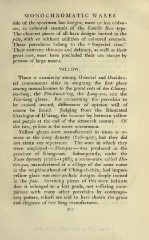Page 373 - Oriental Series Japan and China, Brinkly
P. 373
MONOCHROMATIC WARES
side of the specimen has designs, more or less elabor-
ate, in coloured enamels of the Famille Rose type.
The choicest pieces of all have designs incised in the
pate, with or without addition of coloured enamels.
These porcelains belong to the "
Imperial class."
Their extreme thinness and delicacy, as well as their
great cost, must have precluded their use except by
persons of large means.
YELLOW.
There is unanimity among Oriental and Occiden-
tal connoisseurs alike in assigning the first place
among monochromes to the grand reds of the Chiang-
tou-hung, the Pin-kwo-ts'ing, the Lang-yao, and the
Fan-hung glazes. But concerning the porcelain to
be ranked second, differences of opinion will of
course be found. Judging from the Illustrated
Catalogue of H'siang, the honour lay between yellow
and purple at the end of the sixteenth century. Of
the two, yellow is the more uncommon.
Yellow glazes were manufactured in times as re-
mote as the Tang dynasty (618907), but they did
not attain any reputation. The ware in which they
were employed Sheu-yao was produced in the
province of Kiang-nan. Subsequently, under the
Tuan dynasty (12601368), a stone-ware called Hu-
tien-yao, manufactured at a village of the same name
in the neighbourhood of Ching-te-chen, had impure
yellow glaze run over archaic designs deeply incised
in the pate. Surviving pieces of this ware indicate
that it belonged to a low grade, not suffering com-
parison with many other porcelains by contempo-
rary potters, which are said to have shown the grace
and elegance of fine Sung manufactures.
303

